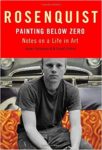
James Rosenquist
American, 1933-2017
Sky, 1981
color lithograph
28 x 28 in.
SBMA, Museum purchase with funds provided by the National Endowment for the Arts and the Contemporary Collectors Group in memory of Rowe Giesen
1982.51.4

Cover of Rosenquist's book
Rosenquist himself always shied away from the term Pop, which his work would eventually epitomize. “Andy Warhol, Roy Lichtenstein, and I are so often mentioned in the same breath you’d have thought we all lived together in some abandoned amusement park…What united us, you might say, was dread of the drip, the splash, the schmear, combined with an ironic attitude toward the banalities of American consumer culture. If anything,” he wrote, “you might say were were antipop artists.”
POSTSCRIPT
A pioneer of the Pop art movement, James Rosenquist rearranges and overlaps images and symbols to create fragmented icons that compel the viewer to examine the familiar in a more abstract and provocative way. At the brink of the Digital Revolution, Rosenquist contemplated the human relationship to technology, the environment, and religion in this stunning portfolio of seven lithographs featuring imagery derived from the sciences, nature, and mass media.
Rosenquist’s references to mass-produced goods and to magazines, films and other aspects of the mass media, together with his dispassionate and seemingly anonymous technique, ensured that he was regarded as one of the key figures in the development of Pop art in the United States. In 1948, while still in school, he won a scholarship to study at the Minneapolis School of Art, and from 1952 to 1955 he studied painting at the University of Minnesota. In 1955, he moved to New York to study at the Art Students League on a scholarship. He earned his living as a billboard painter from 1957, and in 1960 he began to apply similar techniques of grossly enlarged and fragmented images to huge paintings.
Paddle8.Inc
COMMENTS
James Rosenquist, Pop Art Icon, Dies at 83
APRIL 1, 2017 4:19 PM
by MARK GUIDUCCI
A commercial billboard painter who went on to become one of the most recognized artists of the Pop movement and a giant of American postwar painting, James Rosenquist died at home yesterday in New York City.
Rosenquist was born in rural Grand Forks, North Dakota during the Great Depression, the only child of an amateur artist mother and Mobil gasoline station manager father. “A dollar was as rare as frog hair,” he wrote in his 2009 autobiography, Painting Below Zero. Rosenquist remembered seeing early visions across the vast, otherworldly landscape of the Great Plains. One of his first encounters with art took place at the Minneapolis Institute of Art, where he saw Egyptian mummies that reminded him of his grandfather, whose body was preserved in a coffin on the porch of the family house throughout one frigid Dakota winter, impossible as it was to bury him in the frozen hard ground. He remembered some time later, while living in Ohio, coming across “the enigma of collage” for the first time, “something I would spend my life trying to unravel.”
Rosenquist began painting professionally in 1954, after graduating with an Associate’s degree in Arts from the University of Minnesota. His first assignment was a billboard for Coca-Cola, followed by others for clients like Northwest Airlines and Corby’s whiskey, work which took him around the country before he landed in New York City in the late fifties. “Billboard painting was really like an old master’s school of painting,” Rosenquist wrote. “Training like that doesn’t exist anywhere now.”
Working on advertisements at a colossal scale allowed Rosenquist to see the most commonplace, commercial objects as abstract forms, a revelation that became the basis for his practice. He had his first solo show at Green Gallery in 1962 and in 1965, after joining up with Leo Castelli Gallery, debuted perhaps his most famous work, the 51-panel, 86-foot-long F-111. The immersive work occupied every wall of Castelli’s gallery—today we’d probably call it an installation—and depicted a US Air Force fighter jet punctuated by everyday American imagery such as an umbrella, spaghetti, light bulbs, a cake, and a hairdryer that resembled a nuclear warhead. Purchased by collectors Robert and Edith Scull as a single work (the panels were meant to be sold separately), F-111 is now in the permanent collection of MoMA. The masterpiece was directional and exemplified style in which Rosenquist would paint up until his death yesterday.
Rosenquist threw images together with a frenzied pacing that felt immediately familiar to the modern era. Bombarded by mass media, the midcentury American mind was in a constant state of cataloguing, processing, and evaluating experiences, trying to see the big picture but always getting mired in the details. It only made sense that Rosenquist, a “commercial” artist gone “fine”, would be the one to untangle those details. As Artforum once put it, Rosenquist painted “the clutter that adds up to the emptiness of American space.” Look at Instagram or even Snapchat filters, and it’s hard not to see Rosenquist in the background.
Rosenquist himself always shied away from the term Pop, which his work would eventually epitomize. “Andy Warhol, Roy Lichtenstein, and I are so often mentioned in the same breath you’d have thought we all lived together in some abandoned amusement park…What united us, you might say, was dread of the drip, the splash, the schmear, combined with an ironic attitude toward the banalities of American consumer culture. If anything,” he wrote, “you might say were were antipop artists.”
